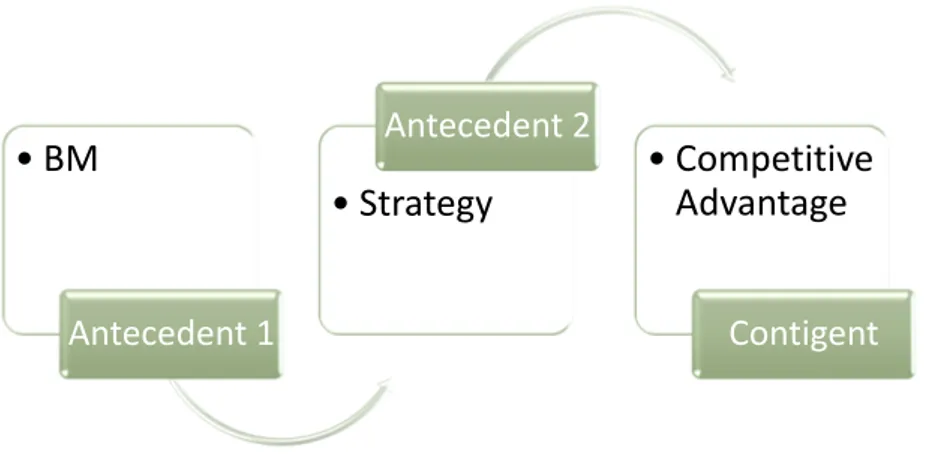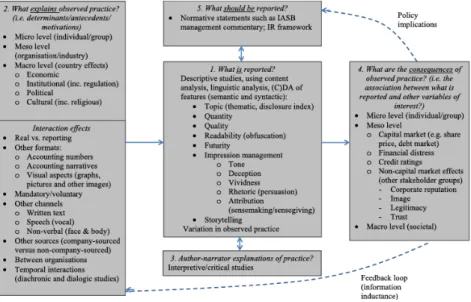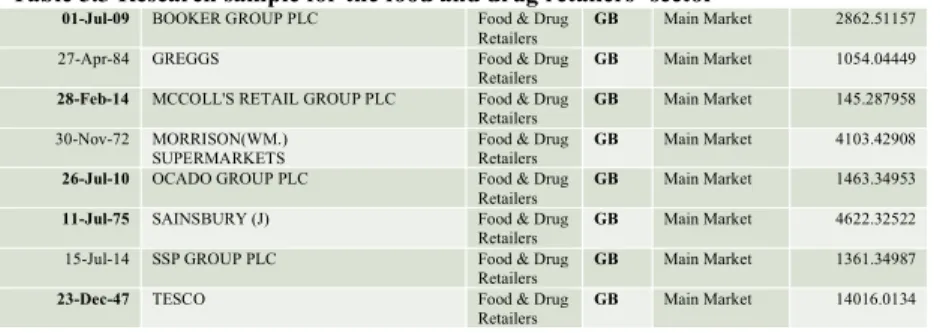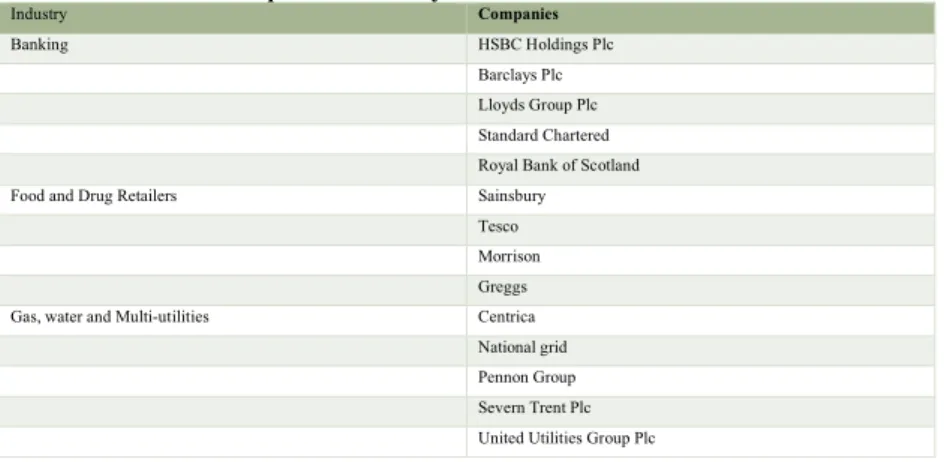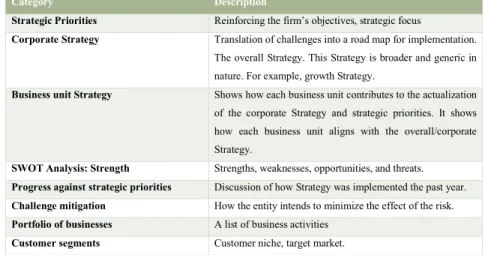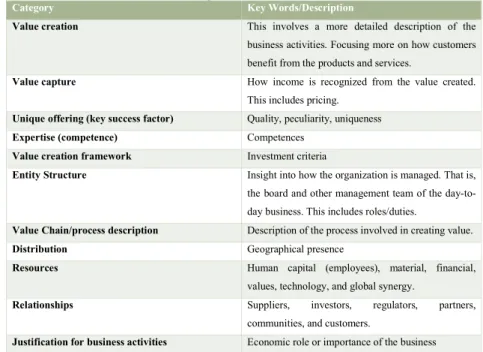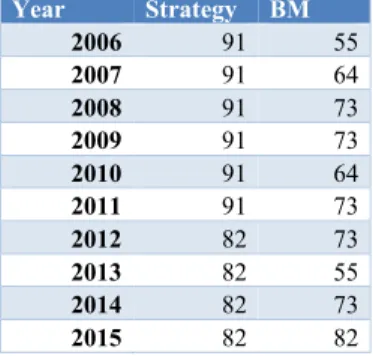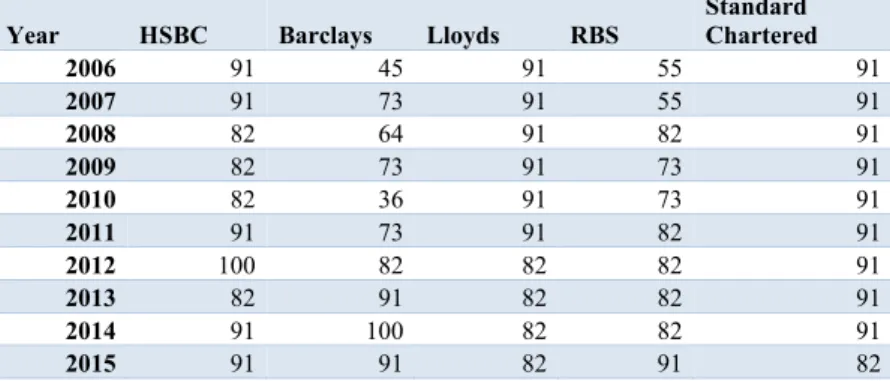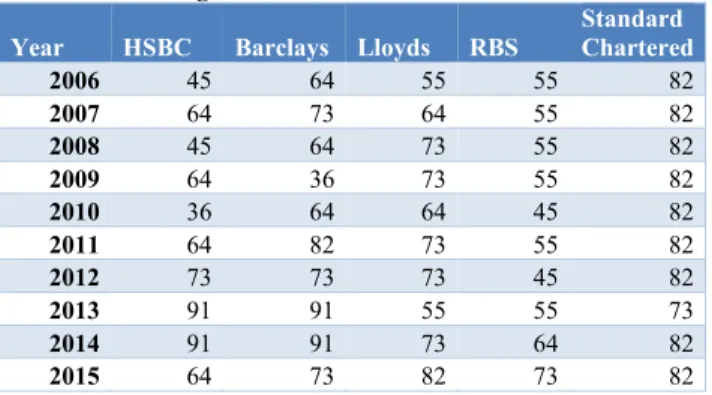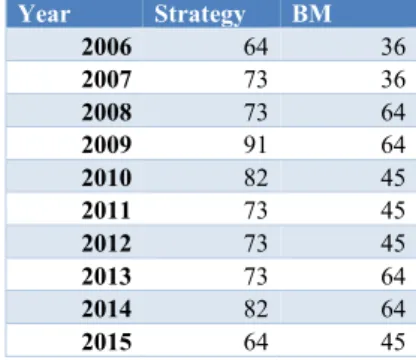Strategy and Business Model Disclosure in Corporate Annual Reports:
A Study of UK Listed Companies
Adeola Deborah Adekemi
A Thesis Submitted for the Degree of
Doctor of Philosophy in Accounting
Essex Business School
University of Essex
ACKNOWLEDGEMENT
I wish to express my deepest gratitude to the people and organisations that have contributed, directly and indirectly, to the completion of this thesis. Firstly, I would like to acknowledge my supervisor, Dr Magda Abou-Seada for her kind guidance, support and encouragement. I would also like to thank my second supervisor Dr Anastasia Kopita for her advices and insights. My appreciation also goes to the board chairman Prof. Kelum Jayasinghe for his valuable comments, advice and supports. I am also grateful to the academic and administrative staff of Essex Business School at the University of Essex for their kind support, as well as teaching opportunities (as a graduate teaching assistant), and trainings which have enriched my teaching experience.
An extra huge acknowledgement goes to my husband/sponsor Babajide Adekemi and to my four children, Ayomikun Adekemi, Isaac Adekemi, Wonder Adekemi and John Adekemi for their support and understanding throughout this journey. Lastly, my appreciation goes to the academics and good friends who have been supportive both personally and professionally throughout this intellectual journey.
iii
DEDICATION
This thesis is dedicated to God Almighty! I give all the glory to God Almighty, who has endowed me with good health, strength and perseverance to come to the end of this intellectual journey.
DECLARATION
I hereby declare that this submission is my own work, and to the best of my knowledge, it contains no materials previously published or written by another person, nor material which to a substantial extent has been submitted for the award of any other degree or diploma of a university or other institution of higher learning.
v
ABSTRACT
The UK Companies Act 2006 has made it a legal requirement for companies, since October 2013, to disclose their ‘Strategy’ and ‘Business Model’ as part of their annual report. The Act, however, does not define what is meant by the two terms. This means that the content of the disclosure remains at the discretion of managers. Prior to this, the UK 2010 Corporate Governance Code required companies to disclose their Strategy and Business Model. The Code, however, is based on a ‘comply or explain’ approach.
This study contributes to the understanding of the disclosure of Strategy and Business Model in the annual reports of UK listed companies before and after the introduction of the regulatory requirements. To achieve this, the thesis aims to investigate the extent of the disclosure of Strategy and Business Model, the impact of regulations and the determinants of such disclosures. The sample includes companies operating in three industry sectors: Banking; Food and Drug Retailers; and Gas, Water and Multi-utilities, over a period of 10 years, taking into consideration, the periods before and after the Corporate Governance and Companies Act requirements.
To achieve the aims of the thesis, it has been necessary to adopt a pragmatic approach, which entails the use of results from a qualitative approach as inputs to a quantitative approach. Further, the study adopts a longitudinal approach and collects empirical data from annual reports and databases. This study also relies on agency and signalling theory to provide explanations on Strategy and Business Model disclosures in annual reports. The study finds that the mandatory requirement has had a statistically significant influence on the disclosure of both Strategy and Business Model. However, the practice of Business Model disclosure is not yet at the same level as Strategy. Lastly, the findings reveal that disclosure is mostly affected by market and corporate governance incentives.
TABLE OF CONTENTS Acknowledgement ... ii Dedication...iii Declaration ...iv Abstract ... v List of Tables ... x
List of Figures ... xii
List of Acronyms ... xiii
Chapter 1 Introduction to the Thesis ... 1
1.1. Background to the Study ... 1
1.2 Motivation and Justification for the Study ... 5
1.3 Research Objectives and Questions ... 7
1.4 Research Methodology and Methods ... 8
1.5 Contributions of the Study... 9
1.6 Structure of the Thesis ... 9
Chapter 2 Review of the Literature ... 11
2.1 Chapter Overview ... 11
2.2 Information asymmetry and corporate disclosures ... 11
2.2.1 The role of corporate disclosure in capital markets ... 13
2.2.2 Integrated Reporting... 14
2.2.3 National Factors and Disclosures... 15
2.2.4 Disclosure Regulation... 18
2.2.5 Corporate Governance and Corporate Disclosure ... 19
2.2.6 Voluntary versus Mandatory Disclosure ... 21
2.3 Strategy ... 23
2.3.1 Levels of Strategy in an Organization ... 24
2.4 BM ... 26
2.5 The nature of the interaction between Strategy and BM ... 29
2.6 Narrative Reporting and the Annual Reports ... 33
2.6.1 The Development of Strategy and BMs Disclosures in the UK ... 33
2.6.2 Strategy Disclosure in Annual Reports ... 35
2.6.3 BM Disclosure in Annual Reports ... 37
2.7 The Relevance of Strategy and BM Disclosure in Annual Reports ... 38
vii
2.9 Chapter Summary ... 42
Chapter 3 Theoretical Framework ... 45
3.1 Chapter Overview ... 45
3.2 Agency Theory ... 46
3.2.1 Governance Mechanisms ... 48
3.3 Signalling Theory ... 49
3.5 Connecting Agency and Signalling Theories (Theoretical Pluralism) ... 51
3.6 The relevance of the theories to this study ... 54
3.7 Chapter Summary ... 57
Chapter 4 Hypotheses Development ... 58
4.1 Chapter Overview ... 58
4.2 Contractual Incentives ... 59
4.2.1 Debt Contract (Leverage) ... 60
4.2.2 Poor Performance (Loss) ... 62
4.2.3 Financial Distress ... 63
4.3 Market Incentives ... 63
4.3.1 Analysts following ... 64
4.3.2 Listing age ... 65
4.4 Corporate Governance Incentives ... 65
4.4.1 Compensation ... 66 4.4.2 Board composition ... 68 4.4.3 Board size ... 69 4.4.4 Active boards ... 70 4.5 Disclosure Regulation ... 71 Chapter 5 Methodology ... 73 5.1 Chapter Overview ... 73
5.2 Research Assumptions and Paradigms ... 74
5.3 Framework for Narrative Disclosure Research ... 77
5.4 Research Design ... 79
5.4.1 Research Sample ... 79
5.4.2 Sample Period ... 82
5.4.3 Media Selection: Annual reports ... 83
5.5 Research Method ... 84
5.5.1 Unit of analysis ... 86
5.6 Reliability and Validity in Content Analysis ... 89
5.6.1 Reliability ... 89
5.6.2 Validity ... 91
5.7 Model specification and variable measurement ... 92
5.8 Chapter Summary ... 94
Chapter 6 Strategy and BM Disclosure Practice ... 96
6.1 Chapter Overview ... 96
6.2 Micro Level Analysis of the Banking Sector ... 96
6.2.1 HSBC ... 97
6.2.2 Barclays ... 98
6.2.3 Lloyds ... 99
6.2.4 RBS ... 100
6.2.5 Standard Chartered ... 101
6.3 Meso Analysis of the Banking Industry ... 102
6.3.1 Strategy Disclosure ... 102
6.3.2 BM Disclosure ... 103
6.4 Micro Level Analysis of the Food and Drug Retailers’ Industry ... 104
6.4.1 Tesco PLC... 105
6.4.2 Morrisons ... 106
6.4.3 Sainsbury ... 107
6.4.4 Greggs ... 108
6.5 Meso Level Analysis of Food and Drug Retailers’ Industry ... 109
6.5.1 Strategy Disclosure for Food and Drug Retailers’ Industry ... 109
6.5.2 BM Disclosure in the Food and Drug Retailers’ Industry ... 110
6.6 Micro Level Analysis of Gas, Water and Multi-Utilities Industry ... 111
6.6.1 Centrica PLC... 111
6.6.2 United Utilities ... 112
6.6.3 National Grid ... 113
6.6.4 Pennon ... 114
6.6.5 Severn Trent ... 114
6.7 Meso Level Analysis of the Gas, Water and Multi-Utilities Industry ... 115
6.7.1 Strategy Disclosure in the Gas, Water and Multi-Utilities Industry ... 115
6.7.2 BM Disclosure in the Gas, Water and Multi-Utilities Industry ... 116
6.8 Chapter Summary ... 117
ix
7.1 Chapter Overview ... 118
7.2 Extent of Disclosure ... 118
7.2.1 Extent of Strategy Disclosure during Voluntary Period ... 119
7.2.2 Extent of Strategy Disclosure during Mandatory Period ... 120
7.2.3 Extent of BM Disclosure during Voluntary Period ... 122
7.3 The extent of the Influence of Regulation on Disclosure ... 123
7.3.1 The extent of the influence of Corporate Governance on Strategy and BM Disclosure ... 123
7.3.2 The extent of the influence of mandatory requirement on disclosure... 125
7.4 Disclosure Items ... 126
7.4.1 Strategy Disclosure Items ... 126
7.4.2 BM Disclosure Items ... 130
7.5 Chapter Summary ... 133
Chapter 8 The Determinants of Strategy and BM Disclosure ... 136
8.1 Chapter Overview ... 136
8.2 Descriptive Statistics ... 137
8.3 Correlation Analysis ... 139
8.4 Regression Results ... 142
8.4.1 Determinants of Strategy Disclosure in Annual Reports ... 142
8.4.2 Determinants of BM Disclosure in Annual Reports ... 148
8.5 Chapter Summary ... 152
Chapter 9 Summary and Conclusion ... 155
9.1 Chapter Overview ... 155
9.2 Summary ... 155
9.3 Research Questions and Key Findings ... 162
9.4 Summary of Contributions ... 164
9.5 Concluding Remarks and Recommendations for Future Study ... 165
References ... 167
LIST OF TABLES
Table 3.3.1 Summary of agency and signalling theory assumptions ... 53
Table 5.1 Research sample for the banking sector ... 81
Table 5.2 Research sample for the GWM sector ... 81
Table 5.3 Research sample for the food and drug retailers’ sector... 81
Table 5.4 Research sample for the study... 82
Table 5.5 Strategy Disclosure categories ... 88
Table 5.6 BM disclosure categories ... 89
Table 5.7 Definition of variables ... 94
Table 6.1 HSBC Strategy and BM Disclosure Level... 98
Table 6.2 Barclays Strategy and BM Disclosure Level ... 99
Table 6.3 Lloyds Strategy and BM Disclosure Level ... 100
Table 6.4 RBS Strategy and BM Disclosure Level ... 100
Table 6.5 Standard Chartered Strategy and BM Disclosure Level ... 102
Table 6.6 Banking Sector Strategy Disclosure Level ... 103
Table 6.7 Banking Sector BM Disclosure Level ... 104
Table 6.8 Tesco Strategy and BM Disclosure Level ... 106
Table 6.9 Morrisons Strategy and BM Disclosure Level ... 107
Table 6.10 Sainsbury Strategy and BM Disclosure Level ... 108
Table 6.11 Greggs Strategy and BM Disclosure Level... 109
Table 6.12 Food and Drug Retailers' Strategy Disclosure Level... 110
Table 6.13 Food and Drugs Retailers' Strategy Disclosure Level ... 111
Table 6.14 Centrica Strategy and BM Disclosure Level ... 112
Table 6.15 United Utilities Strategy and BM Disclosure Level ... 113
Table 6.16 National Grid Strategy and BM Disclosure Level ... 113
Table 6.17 Pennon Strategy and BM Disclosure Level ... 114
Table 6.18 Severn Trent Strategy and BM Disclosure Level ... 115
Table 6.19 GWM Strategy Disclosure Level ... 116
Table 6.20 GWM BM Disclosure Level ... 117
Table 7.1 Strategy Disclosures during Voluntary Period ... 120
Table 7.2 Strategy Disclosure during Mandatory Period ... 121
Table 7.3 BM Disclosure during Voluntary Period ... 122
xi
Table 7.5 Significance of corporate Governance requirement on Strategy & BM
disclosures ... 125
Table 7.6 Significance of mandatory regulation on Strategy and BM disclosures ... 126
Table 7.7 Strategy Disclosure Items in the Banking Industry ... 127
Table 7.8 Strategy Disclosure Items in the Gas, Water & Multi-utilities Sector ... 129
Table 7.9 Strategy Disclosure Items in the Food and Drug Retailers Sector ... 130
Table 7.10 BM Disclosure Items for the Banking Sector ... 131
Table 7.11 BM Disclosure Items for the GWM Sector ... 132
Table 7.12 BM Disclosure Items for the Food & Drug Retailers’ Sector... 133
Table 8.1 Descriptive Statistics of the Sample ... 139
Table 8.2 Correlation ... 141
Table 8.3 Regression results for Strategy disclosure ... 147
Table 8.4 : Regression result for the determinants of BM disclosure in annual reports ... 152
LIST OF FIGURES
Figure 2.1 Definitions of Strategy ... 24
Figure 2.2 The strategic process of value creation ... 32
Figure 3.1 Theoretical framework for the study ... 56
Figure 5.1 Framework for narrative disclosure research ... 78
Figure 6.1 Disclosure Level (%) of Strategy and BM ... 184
Figure 6.2 Disclosure level (%) of Strategy and BM ... 184
Figure 6.3 Disclosure level (%) of Strategy and BM ... 185
Figure 6.4 Disclosure level (%) of Strategy and BM ... 185
Figure 6.5 Disclosure level (%) of Strategy and BM ... 186
Figure 6.6 Banking Industry Strategy Disclosure ... 186
Figure 6.7 Banking Industry BM Disclosure ... 187
Figure 6.8 Disclosure level (%) of Strategy and BM ... 187
Figure 6.9 Disclosure level (%) of Strategy and BM ... 188
Figure 6.10 Disclosure level (%) of Strategy and BM ... 188
Figure 6.11 : Disclosure level (%) of Strategy and BM ... 189
Figure 6.12 Food and Drug Retailers’ Industry Strategy Disclosure ... 189
Figure 6.13 Food and Drug Retailers’ Industry BM Disclosure ... 190
Figure 6.14 Disclosure level (%) of Strategy and BM ... 190
Figure 6.15 Disclosure level (%) of Strategy and BM ... 191
Figure 6.16 Disclosure level (%) of Strategy and BM ... 191
Figure 6.17 Disclosure level (%) of Strategy and BM ... 192
Figure 6.18 Disclosure level (%) of Strategy and BM ... 192
Figure 6.19 Gas, Water and Multi-Utilities Industry Strategy Disclosure ... 193
xiii
LIST OF ACRONYMS
ACCA - The Chartered Institute of Certified Accountants AR – Annual Report
ASB - Accounting Standards Board BM - Business Model
CICA - Canadian Institute of Certified Accountants CEO – Chief Executive Officer
CSR – Corporate Social Responsibility
EASD - European Association of Securities Dealers FASB - Financial Accounting Standards Board FRC - The Financial Reporting Council FRS - Financial Reporting Standard Board FSA - Financial Services Authority FTSE - Financial Time Stock Exchange GWM - Gas Water and Multi-Utilities
HSBC – Hongkong and Shanghai Banking Corporation IAS - International Accounting Standard
IASB - International Accounting Standards Board IC – Intellectual Capital
ICAEW - Institute of Chartered Accountants in England and Wales IFAC - International Federation of Accountants
IFRS - International Financial Reporting Standard IPO - Initial Public Offerings
MD&A - Management Discussion and Analysis
OECD - Organisation for Economic and Co-operation and Development OFR - Operating and Financial Review
RBS - Royal Bank of Scotland
SEC - Securities and Exchange Commission UK - United Kingdom
CHAPTER 1 INTRODUCTION TO THE THESIS
1.1.Background to the Study
The widening gap between statutory corporate disclosure and the actual needs of investors and stakeholders has become increasingly apparent as business practices have developed and more sophisticated investment tools have become widespread. In addition, the issue of transparency in the annual report has gained a high profile in the last few years, particularly following events such as the Parmalat and WorldCom accounting scandals (O’Regan, 2010). Managers have better information than outsiders as well as incentives to favourably bias the information they supply to outsiders and take actions that result in deadweight losses and thus reduce firm and equity values (Jensen and Meckling, 1976; Watts and Zimmerman, 1986).
Information asymmetry between the firm and third parties, whether these are investors, creditors, employees or the public authorities, has been considered as one of the main culprits of financial and economic crisis (Yeoh, 2010). Hence, in as much as transparency is closely related to corporate disclosure practices, disclosure, whether voluntary or mandatory, would have the virtue of reducing information asymmetries, allowing effective control of managers, and (re-) establishing good governance.
Additionally, corporate disclosure is critical for the functioning of an efficient capital market Healy and Palepu (2001)1. In sum, though the problem is not new, the last economic crisis has installed transparency, and thus disclosure, as a one-stop shopping solution (Farvaque et al., 2011). Interestingly, Farvaque et al. (2011) questioned if the magnitude of attention and emphasis placed on disclosure is justified?
1 ‘Disclosure research draws upon economic information asymmetry arguments and agency theory,
The accounting and financial reporting system is a critical source of verifiable information that is useful in monitoring and evaluating managers as well their decisions and strategies (Watts and Zimmerman, 1986; Bushman and Smith, 2001). Firms provide disclosure through regulated financial reports, including the financial statements, footnotes, management discussion and analysis, and other regulated filings (Healy and Palepu, 2001).
What is disclosed is viewed as information which may be in the form of financial information (quantitative or numerical in nature) or non-financial information (narratives, qualitative text) (Beattie, 2014). Accounting narratives offer a very rich and complex set of inscriptions and represent a distinct genre of business communications (Rutherford, 2005; Rutherford, 2013). Narrative reporting complements financial accounting reporting and includes discussions on management’s take on future prospects and risks, brand equity considerations, and the planned management response among others (Yeoh, 2010; Hassanein and Hussainey, 2015). Policymakers have long emphasised the importance of narrative disclosures in helping investors understand a company’s financial performance and risks (see Leung et al., 2015). Tennyson et al. (1990) highlighted that the narrative section of the annual report is management’s unique opportunity to communicate directly with present and potential shareholders and creditors.
Also, prior literature has provided evidence on narrative reporting being associated with information asymmetry arising from the separation between corporate ownership and management is perceived to be resolved through corporate disclosure, in particular narrative reporting (Beattie, 2014; Bromwich, 1992). The focus of this study is on accounting narratives, in particular, Strategy and Business Model (hereafter, BM) disclosure. A company’s Strategy is the game plan that management uses to stake out a
market position, conduct its operations, attract and please customers, compete successfully, and achieve organizational objectives (Arthur and Thompson, 2017). According to Rumelt et al. (1991) Strategy is about the direction of organizations, it includes those subjects that are of primary concern to senior management, or to anyone seeking reasons for the success and failure among organizations. Meanwhile, an organization’s BM is its system of transforming inputs, through its business activities, into outputs and outcomes that aim to fulfil the organization’s strategic purposes and create value over the short, medium and long term (Gould, 2014). Strategy and BMs are fundamental to performance hence it has been argued that that they are complements and not substitutes (Rudtsch et al., 2014).
In disclosing valuable information such as Strategy and BM management confronts a dilemma; much of the information that investors need in forecasting cash flow with less uncertainty, and hence increase the value of the firm, is the same information that could affect proprietary costs imposed by the reaction of competitor(s) and other actors to the information released (Healy and Palepu, 2001; Coebergh, 2011a). It is doubted that information can be made available to the securities market without being available to competitors. In which case, management has to examine the cost and benefit of releasing such valuable information, considering the valuation need of the information and the possible proprietary costs associated with such disclosure.
A description of the business is essential for an investor to gain an understanding of the industries and markets in which the entity operates (see Alberti et al., 2009). This includes its segments, products and services, BM and processes, distribution methods, the business structure including the main operating facilities and their location. Further, in order to improve the quality of corporate reporting, a guideline issued by The Canadian Institute of Chartered Accountants (CICA, 2002) emphasizes the
importance of disclosing according to a strategic view of business. This framework suggests that accompanying narrative information concerning company vision (core business and long-term business Strategy), critical success factors, capabilities (resources) for achieving desired results, expected results, and connected risks and opportunities should be included in annual reports. Furthermore, Beretta and Bozzolan (2008) described the ‘richness’ of the content of annual reports as a function both of the width of the disclosures on different topics regarding a firm’s BM and value-creation Strategy, and of the depth of the disclosures about the presence insights into a firm’s future performance.
Thus, ‘disclosure is viewed as a rational trade-off between costs and benefits – a strategic managerial decision involving complex interdependencies’ (see Beattie, 2014). In line with this argument, The Steering Committee of the Financial Accounting Standard Board suggested the process management should adopt to offer, voluntarily, high-quality disclosure. The aim of the process is to recognize and disclose information that is useful to investors without affecting the company’s competitive position (FASB, 2001a). Accordingly, it was stressed that it should be considered whether voluntary disclosures about the company’s forward-looking strategies and plans and metrics would adversely affect the company’s competitive position and whether the risk of adversely affecting competitive position exceeds the expected benefit of making the voluntary disclosure.
Nonetheless, the concern that annual reports, particularly narrative reports, are becoming too long and complicated, such that key messages are lost in ‘a sea of detailed and regulatory disclosures’, and how best to develop narrative reporting is a debate in the UK, Europe, and worldwide (see Beattie and Smith, 2013).
1.2 Motivation and Justification for the Study
Whittington and Yakis-Douglas (2010) stressed that there is a concern that the long-term strategies of firms are not being adequately understood to serve the long-long-term interests of both firms and economies more widely. Hence, they envisaged that Strategy communications would shift from the domain of voluntary disclosure towards more mandatory disclosure. In line with this argument for example, corporate laws and various capital market regulations in the UK lay down the minimum level of access to key corporate information. In 2010, the UK Corporate Governance Code introduced a requirement for listed companies to disclose in their annual reports their BM and Strategy for delivering corporate objectives (FRC, 2010a). The requirement arose from responses to consultation on revision of the previous version of the code where respondents asked for more contexts with which to interpret directors’ identification of key risks.
Also, in 2012, the UK government proposed a new framework included in The Companies Act (2006) for narrative reporting to include a strategic report, though like the business review, but quoted companies are required to include a report on their Strategy, their BM and any human right issues, effective from October 2013 (FRC, 2012a). The UK Corporate Governance Code adopts a ‘comply or explain principle’, however, although the amended Companies Act has made the disclosure of Strategy and BM mandatory, the content of such disclosure remains at the discretion of managers, as the Act does not specify the content of the disclosures. However, The FRC made a call for comments about its guidance on such disclosures. The conclusion of government after the analysis of responses is to allow companies to tell an integrated story in their own word, starting with their BM and Strategy. Furthermore, Richard Lu and Wu Tucker (2012) note that very little research on Strategy disclosure exists even though it
has been touted as a potential alternative to the (alleged) “short-termism” of providing quarterly earnings. Furthermore, Stefanovic and Milosevic (2012) argue that though “BM” and “Strategy” are among the most heavily used terms in the field of business and management, however, the meaning of these terms is not very well understood. This current study contributes to the understanding of both Strategy and BM and to their disclosure.
Additionally, IFAC (2014) pointed out that although BM reporting is on the increase, it is a long way off from being a mature practice. In their study, Alberti et al. (2009) contend that there is a ‘technical gap’ about the concept of ‘BM’ that standard setters can only fill with the suggestion of a framework that companies can adopt for the fair representation of BM in order to disclose such type of information to capital providers and analysts in a decision useful narrative report. This current study contributes to the literature on Strategy and BM by developing a framework for the interpretation of meanings of Strategy and BM and research into the disclosure of Strategy and BM.
Further, Bini et al. (2016) called out for an investigation into BM disclosure practice among different industries, and the possible determinants of such disclosures. Also, Beattie and Smith (2013) called for an investigation of the extent and nature of reporting of the components of BM. This study focuses on Strategy and BM disclosure in annual reports for listed companies because the new legislations were intended mostly for these companies. The theoretical framework employed by this study is agency and signalling theories. This study also uses content analysis to investigate the disclosure practice of Strategy and BM. This leads us to the research objectives and questions this study intends to investigate.
1.3 Research Objectives and Questions
The overall aim of this thesis is to contribute to the understanding of Strategy and BM disclosure in the annual reports. This study is guided by the framework for research on narrative disclosures developed by Beattie (2014). The first objective of this study is to develop a comprehensive disclosure framework to evaluate the content of Strategy and BM disclosures in annual reports, and to investigate current practices of Strategy and BM disclosure. The methodological issues of importance here are thus the concepts themselves (Strategy and BM); the identification of underlying themes and their measurement (measured as 1 if disclosed and 0 for non-disclosure). Additionally, this first objective relates to the first and fifth questions in the proposed narratives research framework (Beattie, 2014) ‘what is reported and what should be reported’. Thus, the first objective of this study further examines how companies voluntarily disclosed their Strategy and BM in the annual reports between 2006 and 2012 and mandatorily but with discretion of disclosure content between 2013 and 2015.
In addition, the components of Strategy and BM that are most and least disclosed are identified. Thereafter, this first objective investigates the effect of regulation (both corporate governance requirement and mandatory requirement) on the disclosure of Strategy and BM. Second, this study examines the potential determinants of Strategy and BM disclosures in annual reports of UK companies, using regression analysis. This objective is related to the second question in the framework ‘what explains observed practice’.
These research objectives drive the following research questions. The first objective drives questions 1 and 2 while, the second objective relates to question 3 below:
1. Has there been any change in the level of Strategy and BM disclosure between 2006 and 2015?
2. What is the extent of Strategy and BM disclosure in the annual reports? a. What items of Strategy and BM are most disclosed in the annual reports?
b. How has regulation been able to influence the disclosure of Strategy and BM? 3. What are the determinants of Strategy and BM disclosure in the annual reports of UK
listed companies?
1.4 Research Methodology and Methods
Given the set objectives and research questions of this study, the philosophical perspective applied in the study is a pragmatic approach. This approach provides the appropriate understanding of the theory, methodology and methods in this context, and this paradigm shows that inductive results from a qualitative approach can serve as inputs to the deductive goals of a quantitative approach. The data collected will be qualitative (text) in nature. The study adopts agency and signalling theories as the theoretical lens to provide an explanation and better understanding of Strategy and BM disclosure practice.
This study will use a longitudinal study approach to explore and to provide an understanding of the disclosure practice of Strategy and BM in the annual reports of UK companies. Additionally, this study applies a qualitative content analysis technique to explore what is disclosed as Strategy and BM in order to develop an understanding of the content and meaning of such disclosure. As such, a manual thematic analysis was adopted to assess the narrative information disclosed on BM. However, quantitative content analysis and descriptive statistics were adopted to explore the extent of such disclosure (part of the first objective), the effect of regulation on such disclosure. The second objective is examined using regression analysis - hypothesis testing (see Neuendorf, 2002), and data was collected from databases – FAME and IBES2
1.5 Contributions of the Study
This study is an exploratory analysis and contributes to the literature on Strategy and BM disclosure by investigating the extent of Strategy and BM disclosure in the annual reports. Previous research on the disclosure of Strategy in annual reports had been on voluntary disclosure. Additionally, this current study explores the influence of regulation on the disclosure of Strategy and BM. Further, this study examines the possible determinants of the disclosure of Strategy and BM. It is the first empirical study on the effect of regulation on disclosure of Strategy and BM, as well as the determinants and the extent of such disclosure. Thus, this study contributes to the debate about the developments in business reporting models and value creation Strategy. It links the accounting literature with Strategy and BM literature, and develops a disclosure index that can help inform future research.
This current study contributes to the accounting literature on capital market research in the area of regulation and accounting information disclosure. Kothari (2001) highlight that evidence from research on these types of topics is likely to be helpful in capital market investment decisions, accounting standard setting, and corporate financial disclosure decisions. At the same time, this study has successfully answered the call to assess the extent of BM disclosure (Beattie and Smith, 2013), and to examine the potential determinants of BM disclosure, focusing on different industries (Bini et al., 2016).
1.6 Structure of the Thesis
The remainder of this thesis is organised as follows. Chapter 2 briefly reviews the literature and previous studies in the area of Strategy and BM disclosure. In chapter three, the hypotheses development is presented and the independent and dependent variables are described. Chapter four focuses on the discussion of the theoretical lens (agency and signalling) adopted to explain the disclosure practice of Strategy and BM in the annual reports. Thereafter, chapter five
discusses the philosophical perspective, research design and methods of collection and analysis for this study, followed by the three empirical chapters.
Chapter six analyses the first research question, describing the disclosure practice of Strategy and BM for the 10-year period. It investigates what is reported as Strategy and BM. It is a descriptive study that employs the use of content analysis and disclosure index to explore the topic under investigation. The second empirical chapter, chapter seven, examines the extent of such disclosure. It goes further to explore the significance of disclosure difference between voluntary and mandatory periods, investigating the significance of regulations on the disclosure. While, the third empirical chapter, chapter eight examines the second question of the accounting narratives disclosure framework looking at what explains observed practice i.e. determinants of Strategy and BM disclosure. Chapter nine concludes the intellectual journey where the findings of the investigations of the three industries and the three empirical chapters are articulated and discussed. It also presents the contributions of the study to the existing debate on the disclosure of Strategy and BM. In addition, it provides an overview of the research and discusses the limitations of the study. It concludes with the conclusion of the thesis and suggestion for future studies
CHAPTER 2 REVIEW OF THE LITERATURE
2.1 Chapter Overview
This chapter reviews the literature on Strategy and BM disclosure. It does so in order to shed light on the subject matter of this study and to identify the key trends and themes, which will inform the study. The first section in this chapter will review the literature on disclosure. Thereafter, the literature on the concepts of Strategy and BM is discussed. Then, the disclosure of Strategy and BM from previous studies will be reviewed, followed by the relevance, costs and benefits of Strategy and BM disclosure.
2.2 Information asymmetry and corporate disclosures
The problems of information asymmetry have long been highlighted in the literature, in particular in the corporate finance literature (Berle and Means, 1932; Jensen and Meckling, 1976). These information asymmetries oppose the manager and the shareholders, or, following a broader view, they oppose on the one hand those who are commonly called insiders (managers and majority shareholders) and, on the other hand, the outsiders (minority shareholders, creditors, and other stakeholders). One could also include the regulatory authorities among these outsiders, as well as information professionals - the rating agencies and financial analysts. As part of a separation between the ownership of capital and control, information asymmetries pose the problem of the ex post control of the choices of managers by shareholders.
The response provided by the traditional literature related to corporate governance was the definition and implementation of incentive contracts. These were supposed to solve the following two problems: first, the cost of perfect information and, second, the inability of shareholders to process information correctly (which is the major reason for delegating power).
However, incentive mechanisms, whose objectives are to make managers’ interests coincide with those of shareholders, have shown their pernicious effects (Shleifer and Vishny, 1997) and the Enron scandal. Since the 1990s and the first decade of the 21st century, the solution to the problem of information asymmetry seems to be disclosure, supported by an apparent consensus between economic actors, public authorities and the media. In as much as transparency is closely related to corporate disclosure practices whether voluntary or mandatory, the information asymmetry arising from the split between ownership and management is perceived to be resolved through corporate disclosure (Bromwich, 1992).
In contrast, a major conclusion from literature (see for example Healy and Palepu, 2001; Merkl-Davies and Brennan, 2007)is that it is not at all obvious that disclosure, whether mandatory or voluntary, actually increases the knowledge that economic actors have of the company. First, being transparent does not necessarily mean providing information, since third parties are not shielded from disclosures of fraudulent information or the concealment of important information. Furthermore, current regulation does not include all the necessary specifications relating to the disclosure of firm insider information. Second, it is not certain that a firm will give investors the information they need to take decisions. The company can manipulate the information communicated; it can deliberately make it more complex, or it can make it very extensive and difficult to interpret. Transforming information communicated by the company into knowledge usable by investors requires a great deal of work. If disclosure makes this work less profitable for financial analysts and informed agents, it is possible that the overall knowledge of the company will be reduced (Merkl-Davies and Brennan, 2007). Thus, the fact that communication by companies does not create knowledge or even that it reduces the information available to shareholders is very pernicious. When companies do not communicate much, shareholders know that they do not have information at their disposal, and, as we have seen in particular with (Boot and Thakor, 2001), they will try to acquire this in a costly way.
Managers will try, through credible signals like smoothing results or dividends, to supply information on future profits. But if shareholders have the impression of having information, because of an imposed or voluntary communication policy, they will be much less vigilant. They will simply have an illusion of knowledge, rather than a real knowledge. They could therefore take decisions wrongly believing that they have the relevant information. They will be overconfident: they will think that they have good share price expectations, whereas they are mistaken; they will under-estimate their capacity for error.
2.2.1 The role of corporate disclosure in capital markets
Corporate disclosure is critical for the functioning of an efficient capital market (Healy and Palepu, 2001). Firms provide disclosure through regulated financial reports, including the financial statements, footnotes, management discussion and analysis, and other regulated filings (Healy and Palepu, 2001). A major challenge for any economy is the allocation of savings to investment opportunities. According to Beyer et al. (2010) accounting information plays two important roles in market-based economies. First, it allows capital providers (Shareholders and creditors) to evaluate the return potential of investment opportunities (the ex-ante or valuation role of accounting information). Second, accounting information allows capital providers to monitor the use of their capital once committed (the ex-post or stewardship role of accounting information).
The demand for accounting information by outsiders arises for two reasons (ex-ante and ex-post demand for accounting information). First, ex-ante, firms’ managers typically have more information about the expected profitability of firms’ current and future investments than outsiders. This information asymmetry makes it difficult for outside capital providers to assess the profitability of the firm’s investment opportunities. This problem is exacerbated because insiders (both managers and owner-managers) have incentives to exaggerate their firms’ projected profitability. In turn, if capital providers cannot assess firms’ profitability, they will
under-price firms with high profitability and over-price firms with low profitability, potentially leading to market failure.
The information or ‘‘lemons” problem (Akerlof, 1970) and the resulting incentives to disclose additional information have long been recognized in the disclosure literature. It can potentially lead to a breakdown in the functioning of the capital market. For example, consider a situation where half the business ideas are ‘‘good’’ and the other half are ‘‘bad’’. Both investors and entrepreneurs are rational and value investments conditional on their own information. If investors cannot distinguish between the two types of business ideas, entrepreneurs with ‘‘bad’’ ideas will try to claim that their ideas are as valuable as the ‘‘good’’ ideas. Realizing this possibility, investors will value both good and bad ideas at an average level. Therefore, if the lemons problem is not fully resolved, the capital market will rationally undervalue some good ideas and overvalue some bad ideas relative to the information available to entrepreneurs (Healy and Palepu, 2001). Second, the ex-post demand for accounting information arises from a separation of ownership and control (a characteristic of modern economies), which results in capital providers not having full decision-making rights. To solve the ensuing agency problems, both implicit and explicit contracts often use accounting information such as the use of
resources, decisions taken and generated return on investments. Investors value such information ex-post and require a lower rate of return ex-ante when they can rely on such information. Hence, optimal contracts between managers and investors will provide incentives for full disclosure of private information, thus, mitigating the misevaluation problem (see Kreps, 1990).
2.2.2 Integrated Reporting
Integrated reporting has rapidly gained considerable prominence since the formation of the International Integrated Reporting Committee (IIRC – subsequently renamed the International Integrated Reporting Council). Initially, social and environmental disclosures were reported through the corporate annual reports (De Villiers et al., 2014). However, over the last two
decades social and environmental disclosures have increasingly been in stand-alone reports. The increased complexities and length of stand-alone social and environmental reports have led to a move to integrate social, environmental, financial and governance information (Dey and Burns, 2010; Hopwood et al., 2010). The main focus of integrated reporting is to provide;
… a concise communication about how an organisation’s strategy, governance, performance and prospects, in the context of its external environment, lead to the creation of value over the short, medium and long term. … an integrated report may be prepared in response to existing compliance requirements … If the report is required to include specified information beyond that required by this Framework, the report can still be considered an integrated report (IIRC, 2013a, p. 7-8).
Thus, according to the IIRC (2013a, p.3) integrated reporting should contribute to allowing efficient and productive capital allocation and act as a force for financial stability and sustainability. In creating value, the argument for integrated reporting is that the ability of an organisation to create value for itself is linked to the value it creates for others. As such, financial capital providers are also interested in the value an organisation creates for others when it affects the ability of the organisation to create value for itself. Hence, integrated reports should enable providers of financial capital to assess whether, to what extent and how an organisation’s use of, and outcomes for, all the capitals add financial value (IIRC, 2013b).
2.2.3 National Factors and Disclosures
Empirical studies have identified national factors that could explain why firms from the United Kingdom and the United States generally disclose more information than firms from other countries (Dong and Stettler, 2011). These factors include; a nation’s cultural values (Zarzeski,
1996), legal systems (Jaggi and Low, 2000), economic development (Archambault and Archambault, 2003) and financial systems (Riahi-Belkaoui, 2002).
2.2.3.1 National Culture
Culture influences how people perceive situations and organise institutions (Archambault and Archambault, 2003). Hofstede (1991) developed a set of dimensions to characterise national factors and to analyse the differences between these countries: power distance, individualism, uncertainty avoidance, masculinity and long-term orientation. Power distance represents the extent to which people tolerate unequal distribution of power within a society. There will be a less demand for accountability and disclosure in societies with high power distance. Individualism describes the relation between an individual and his or her fellow individuals in a society, the extent to which people are independent as oppose to collectivism. Uncertainty avoidance describes the extent to which people feel challenged by unknown situations. Masculinity describes the division of roles between the sexes in the society. Lastly, long-term orientation describes the time orientation of cultures. It is expected that investors and other stakeholders in short-term oriented societies demand a higher level of disclosure because they appreciate transparency and accountability (Santema et al., 2005). Companies in countries that place a high cultural value on power distance and uncertainty avoidance are likely to exhibit less information disclosure because the business environment is well developed and also because the national economy is oriented toward low-risk relationships. In contrast, companies in societies exhibiting high cultural values in individuality and masculinity are likely to be more transparent and to disclose more (Jaggi and Low, 2000; Gray, 1988).
2.2.3.2 Legal Systems
The extent to which a country protects shareholder rights is different across countries. Countries with low protection are generally characterized by high concentration of equity ownership within firms and lack strong capital markets (see Santema et al., 2005). Legal systems are predicted to
affect disclosure because different legal regimes can lead to different orientation of company acts and accounting regulations on disclosure. Relatively speaking “common law countries like the UK and US protect investors the most, followed by the German law countries and of the three origins of code law system, French civil law countries protect the least” (Porta et al., 1998 p. 1139). The level of enforcement and protection is assumed to influence the level of transparency and accountability (Santema et al., 2005). As such it is expected that companies listed in the UK disclose more information to their shareholders and other stakeholders than companies in countries with lower investor protection.
2.2.3.3 Economic Systems
Some scholars have focused on economic perspectives, arguing that the economic environment is important to the development of accounting in general and reporting and disclosure in particular (Belkaoui, 1983). Put differently, Choi et al. (2005) take a similar approach arguing that the development of a disclosure system closely parallels the development of an accounting system, and the latter is closely influenced by the level of economic development (p. 146). Hence, countries at different stages of economic development are expected to have different accounting practices and disclosure behaviour.
2.2.3.4 National Financial Systems
Further, the national financial systems may substantially affect accounting measures as well as disclosure practices. (Nobes, 1998) suggests that the distinction between “creditor/ insider” and “equity/outsider” financial systems is the key in weighting the degree of market pressure exerted on those who are responsible for disclosure in financial reports. In credit-based countries where banks are the main financial providers, national accounting systems are oriented to protect creditors' rights. Thus, the pressure for information disclosure in these countries is relatively weaker than in countries with developed equity markets. In contrast, in countries with strong equity markets, accounting is designed to help make investors aware of information that may
help predict future performance and associated risks. Disclosure therefore is, intended to meet the information needs of public ownership. Santema et al. (2005) found that national differences in corporate governance and culture do influence the extent to which companies’ disclosure their Strategy. This implies that the corporate governance approach adopted in the UK will influence the disclosure practice of companies.
2.2.4 Disclosure Regulation
Beyer et al. (2010) pointed out that the literature on disclosure provides two main reasons for disclosure regulation. First, the misalignment of insiders’ (entrepreneurs’ or management’s) and investors’ incentives can make it difficult for managers to credibly convey information. From this perspective, disclosure requirements, accounting standards, auditors, and SEC enforcement actions are mechanisms that allow firms to commit to certain disclosure levels and improve the credibility of disclosed information.
Second, the public goods aspect of disclosures results in free-rider problems, creating circumstances in which managers’ incentives to voluntarily disclose information are insufficient even though additional information would improve social welfare. In such cases, regulation mandating the disclosure of certain information can be desirable. Hence, disclosure regulation will, in part, depend on the kind of information that a firm voluntarily discloses or that can (efficiently) be produced by other market participants.
On the other hand, Healy and Palepu (2001) discussed that regulation could also be motivated by concerns other than market failures. This implies that the objective of disclosure regulation could be to redistribute wealth, rather than improve economic efficiency. This leaves an unanswered question: What is the role of regulators in the regulation of Strategy and BM disclosure? Additionally, Leuz and Wysocki (2016) stressed that evidence on the causal effects of disclosure and reporting regulation is still relatively rare. Furthermore, Considering the earlier discussion about the information need ex-ante and ex-post, Beyer et al. (2010) contended that,
the ex-ante and ex-post demands for accounting information might not always result in the information being voluntarily supplied. When managers do not voluntarily disclose all their private information, there is room for disclosure regulation in capital markets.
Whatever the regulation is, disclosure, far from providing the financial stability desired, can on the contrary cause crises. In other words, to ensure that managers give investors the information they need to take decisions, it is important to ensure that the information disclosed is a function of both the width of the disclosures on different topics regarding a firm’s value creation BM and Strategy, and of the depth of the disclosures about the insights into a firm’s future performance (Beretta and Bozzolan, 2008).
Hence, because of the lemons problem, there is a demand for information intermediaries, such as financial analysts and rating agencies, who engage in private information production to uncover managers’ superior information (Healy and Palepu, 2001). Although, the aim of mandated disclosures is to alleviate agency problem, several accounting observers opined that mandated disclosures are becoming increasingly irrelevant, because they do not force managers to reveal pertinent information (see Lev and Zarowin, 1999a; FASB, 2001a).
Goto et al. (2008) stressed that the integrity of corporate disclosure sustains investor confidence in trading securities at fair prices, and hence is at the heart of well-functioning capital markets. In practice, however, a firm’s disclosure may reflect the strategic decisions of self-interested managers, as it involves a number of estimates, judgments, and assumptions. Thus, managers may have an incentive to obfuscate the firm’s true performance, within the allowances of investor protection regulations. As such, disclosure and the institutions created to facilitate credible disclosure between managers and investors play an important role in mitigating these problems (Healy and Palepu, 2001).
2.2.5 Corporate Governance and Corporate Disclosure
in reducing information asymmetries and agency conflicts is ongoing (Gisbert and Navallas, 2013). Recent research argues that these mechanisms (information and governance) are both substitutes (Bushman et al., 2004) and complements (Ahmed and Duellman, 2007). Corporate governance is a natural topic in the discussion of how legal systems exert influence on disclosure (Pagliarussi and Liberato, 2011). The basic question about corporate governance is how suppliers of finance to corporations assure themselves of getting a return on their investment (Shleifer and Vishny, 1997). They justify the focus on shareholders by stating that, contrary to other stakeholders, the former has a sunk investment in the company. If the firm runs into financial difficulties, shareholders are likely to lose their investment whereas other stakeholders such as employees can walk away relatively easy. The OECD, the World Bank, the European Association of Securities Dealers – the EASD – and the European Commission, have adopted this line of argument. Thus, it is argued that financial reporting is shaped by corporate governance approaches (Yeoh, 2010).
So, corporate governance mechanisms are economic and legal institutions that can be altered through the political process (Shleifer and Vishny, 1997). Research has shown that the presence of directors is strongly associated with increased voluntary disclosure (Fama, 1980; Healy and Palepu, 2001; Gisbert and Navallas, 2013). In their study, Santema et al. (2005) concluded that national differences in corporate governance and culture do influence the extent to which companies disclose their Strategy. In this way, the need for Strategy disclosure will be smaller in countries with a dual-board system, than in governance systems with a unitary board system. A larger degree of protection and enforcement will lead to a prevalence of transparency and accountability. An example of this is that companies listed in countries characterized by a strong investor protection are compelled by law to disclose more information to their investors and other stakeholders than companies in countries with weaker investor protection.
According to the UK Financial Reporting Council (FRC), good corporate governance is essential to the effective operation of a free market, which facilitates wealth creation and freedom from poverty (FRC, 2010a). It is argued that the more ingrained the system of corporate governance in a business community, the less the need for a detailed regulation to ensure effective compliance with good standards of business behaviour (FRC, 2010a). Yeoh (2010) opined that under the stakeholder (insider) approach, financial reporting and corporate disclosures appears driven more by the legitimacy and institution theories as management strives to conform to stakeholders’ and regulators’ expectations. However, under the shareholder primacy (outsider) Anglo-saxon approach, financial reporting is used to resolve the information asymmetries between management and shareholders in normal circumstances or applied as an impression management device in opportunistic situations to manipulate investors’ perceptions and response by focusing on the earnings report. This supports the suitability of the theoretical framework adopted for this study – “agency and signalling” suggesting that although corporate disclosure is used to resolve the information asymmetry between management and shareholders, whether disclosure is voluntary or mandatory, corporate disclosure has the potential of a reducing of information asymmetry.
2.2.6 Voluntary versus Mandatory Disclosure
Disclosure theory differentiates between mandatory and voluntary approaches. Voluntary disclosure is a measure of self-regulation or a response to the expectations of stakeholders and civil society for more disclosure (Chandler, 1997). The Financial Reporting Standard Board (FRSB, 2001) defines voluntary disclosure as “disclosure, primarily outside of the financial statements that are not explicitly required by accounting standards or regulations’. Most studies define voluntary disclosure by tracing regulations and accounting standards. For example, (Cooke, 1989 p. 171) defines voluntary disclosure of Swedish companies as “those items that are not stipulated by the Companies Act 1995, the Accounting Act 1976 and by Notices issued by
Accounting Standard Board”. Similarly, Hossain (1994 p. 341) specify voluntary disclosure of companies as ‘…which is not referring to the accounting standards promulgated by the MIA (Malaysian Institute of Accountants), the Companies Act 1965 and the KLSE listing requirements. Voluntary disclosure may be able to be more cost sensitive, but it appears to suffer from biasness associated with the problems of selective dissemination and the adoption of creative accounting in the earnings report.
In contrast, mandatory disclosure results from legislation or regulation. Mandatory reporting especially on a more standardized basis is justified to bridge the deficit of relevant information for users for comparative analysis purposes (Yeoh, 2010). “Mandatory disclosure refers to the existence of disclosure regulation” (Dobler, 2008 p.185). Mandatory disclosure would enhance transparency, help reduce conflicts of interest, deter abusive use of management power, prevent fraud, protect investors, and promote informed decision-making and accountability (Benston et al., 2006; Villiers, 2007). It’s been contended that mandatory disclosure requirements only apply if the disclosure is material (see Beyer et al., 2010).
While any Strategy and BM disclosure in a voluntary regime is discretionary, there is discretion in Strategy and BM reporting in a mandatory disclosure regime as well. The latter stem from disclosure rules that give managers discretion for the quality and content of information disclosed. For the purpose of this research, the requirement to disclose Strategy and BM in the annual report is regarded as mandatory, considering that it is specified in the Companies Act, 2006. However, it is argued that the requirement does not specify the content of such disclosures; therefore, management could still influence the ‘quality’ of the disclosure of Strategy and BMs in annual reports. It appears that the rationale for a mandatory disclosure requirement of strategy and BM information is to create a consistent and continued disclosure level for investors that are not privy to managements’ private information (see Bini et al., 2016). This study examines the disclosure of strategy both during the voluntary and mandatory periods.
2.3 Strategy
Strategy is about competitive positioning, differentiation, and about adding value. Thus, in this way, Strategy is associated with the course of action that allows the firm to create a competitive advantage that enhances its value (Porter, 1985; Besanko et al., 2003). (Middleton, 2006) highlight one unifying theme common with all leading authors on Strategy, namely that all definitions of Strategy concern themselves with the future direction of the organization into that future.
According to Rumelt et al. (1991) firms if not all are in competition; such competition includes, competition for resources, competition for customers, and ultimately competition for revenues that cover the costs of their chosen manner of surviving. Also, for survival, firms make strategic choices which include: the selection of goals; the choice of products and services to offer; the choice of an appropriate level of scope and diversity; the design and configuration of policies of determining how the firm positions itself to compete in product-markets; and the design of organization structure, administrative systems and policies used to define and coordinate work (Rumelt et al., 1991). It is a basic proposition of the Strategy field that these choices have critical influence on the success or failure of the enterprise, and that they must be integrated. It is the integration (or reinforcing pattern) among these choices that make the set a Strategy (Rumelt et al., 1991) Figure 2.1 shows various definitions of Strategy.
Figure 2.1 Definitions of Strategy
2.3.1 Levels of Strategy in an Organization
Strategies can exist at three main levels inside the organization, and these include the corporate level Strategy, business level Strategy, operational or functional level Strategy, financial Strategy and so on. Wright et al. (1998) discussed different strategic levels of action: corporate Strategy, business unit Strategy and functional Strategy. However, this hierarchical view does not necessarily represent the way Strategy is formulated (Slack et al., 2010)
2.3.1.1 Business Unit Strategy:
The strategic business unit is the next level after corporate-level Strategy, originally conceptualized for diversified companies. A business unit is an organizational sub-system, which has a market niche, competitors and organizational mission and goals diverse from other organizational subsystems in the same firm (Wright et al., 1998). This level of Strategy is about how to compete successfully in particular markets. The business level Strategy identifies and builds the strength the business needs in its long term competitive position in the marketplace. It is argued that achieving competitive advantage allows a business to differentiate its products or services from those of competitors to increase market share.
'Competitive Strategy is about being different. It is about chosing differnt sets of activities to deliver a
unique mix of values' Porter, (1991, p. 60)
'a pattern in a stream of decisions' Mintzberg, (2007, p.3)
'Managerial tool for delivering the objectives of the company'
UK CGC
'The game plan that management uses to stake out a market position, conduct its operations, attract and
please customers, compete successfully, and achieve organisational objectives' Thompson and Strickland, (2003)
'The direction and scope of an organisation over the long term, which
achieves advantages in a changing environment through its configurationof resorces and competences with the aim of fulfiling
stakeholder expectations' Gerry et al., (2009 p. 3)
Business Strategy is sometimes called ‘competitive Strategy’ (Johnson et al., 2009). This includes issues such as pricing Strategy, cost leadership and innovation or differentiation, response to competitors’ moves etc. Strategic decisions relate to particular strategic business units (SBU) within the overall organization. Each SBU has a distinct external market for goods or services that is different from another SBU. However, it is argued that business-level strategies should not be disclosed as it directly impacts the survival of an organization against rivals, and such a disclosure would mean giving out business intelligence on a platter of gold.
2.3.1.2 Operational / Functional Strategies
Operational strategies are concerned with how the component of an organization deliver successfully the corporate-level and business-level strategies in terms of processes, people and resources (Johnson et al., 2009). Generally, because successful business strategies depend to a large extent on decisions that are taken or activities that take place at the operational level, operational strategies are vital to successful strategy implementation. Examples of operational strategies include a decision to raise external finance to fund rapid growth, possibly geared towards meeting investment needs. In their study, Pagliarussi and Liberato (2011) discussed the levels of Strategy, and observed that the disclosure with operational Strategy content occurs less frequently than corporate Strategy disclosure. Pagliarussi and Liberato (2011) argued that since the literature clearly indicates that operational Strategy is a way of creating competitive advantage, investors would be expected to know how to interpret operational Strategy disclosure in the valuation of their investment options.
2.3.1.3 Corporate Level Strategy:
Corporate strategy is concerned with “the overall purpose and scope of an organization and how value will be added to the different parts (business units) of the organization” Johnson et al. (2009, p.7). Thus, corporate-level Strategy is conceived in terms of variation in the portfolio of industries in which a firm does business (Beard and Dess, 1981) and in addition, according to
Hofer and Schendel (1978), the operational measures of resource deployment among businesses. Examples include; issues of geographical coverage, diversity of products/services or business units, acquisitions of new businesses, mergers, consolidation, and how resources are allocated between the different parts of the organisation.
Most firms have simple corporate-level strategies, as they compete in only one industry among hundreds that are possible. Other firms however, such as the FTSE 100 largest firms on the London Stock Exchange, typically participate in several industries, and their top managers must contend with the varied and conflicting demands of their industrially specialized subunits (Beard and Dess, 1981). Hill and Jones (2011) stress that the clarity of corporate Strategy is important, and a disclosure of corporate-level Strategy should give an insight into the activities of the company and explicitly stating how shareholder value would be enhanced. Additionally, Johnson et al. (2009) contend that corporate-level Strategy is likely to be concerned with the expectations of owners - the shareholders and the stock market. This expectation could be implicitly or explicitly reflected in a statement of ‘mission’.
2.4 BM
According to Teece (2010) a BM describes the design or architecture of the value creation, delivery and mechanisms a business enterprise employs. Put in other words, Osterwalder and Pigneur (2010) described BM as the rationale of how an organisation creates, delivers and captures value. The essence of a BM is in defining the manner by which the enterprise delivers value to customers, entices customers to pay for value, and converts those payments to profit. Magretta (2002) asserts that a firm’s BM sets the economic logic of how the organization Strategy can create value for the customers at an acceptable price with reasonable profit. In a report, ICAEW (2010) argues that what a firm does internally and what it does through market transactions are described by its BM. Thus, a company’s BM relates to how and why a
